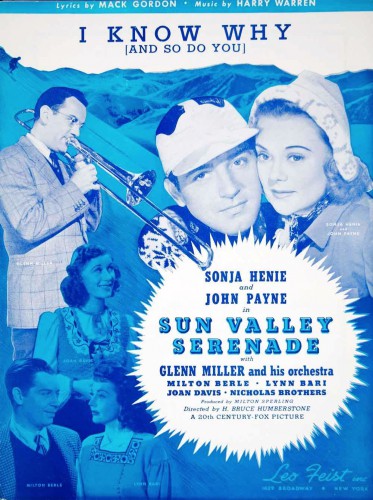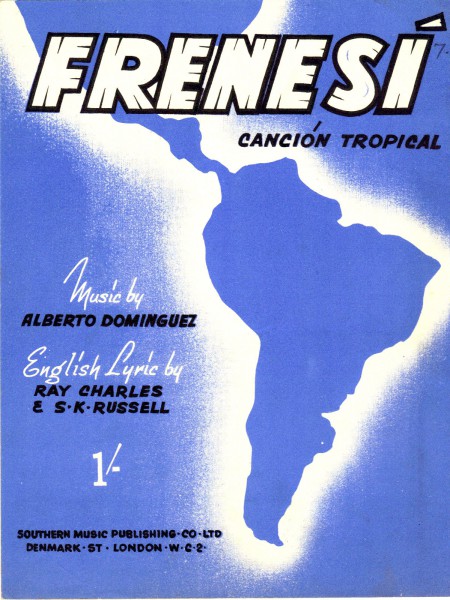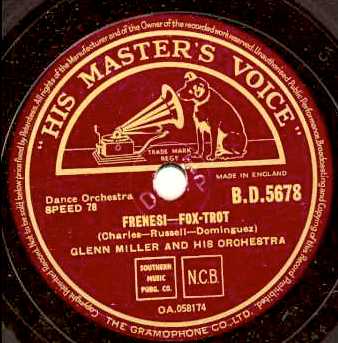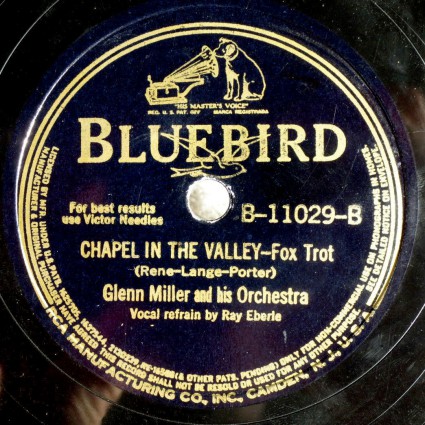Mickey McMickle, Johnny Best, Ray Anthony, Billy May (tp); Glenn Miller, Paul Tanner, Jimmy Priddy, Frank D’Annolfo (tb); Hal McIntyre, Wilbur Schwartz, Ernie Caceres, Tex Beneke, Al Klink (reeds); Chummy MacGregor (p); Jack Lathrop (g); Trigger Alpert (b); Maurice Purtill (d); Ray Eberle, Tex Beneke, Paula Kelly, The Modernaires, Pat Friday (voice dub for Lynn Bari), John Payne, Dorothy Dandridge, The Nicholas Brothers, Six Hits and a Miss (vcl); Bill Finegan, Jerry Gray, Billy May (arr).
20th Century Fox Studios, Hollywood, March 24 – May 3, 1941
After the RCA studio sessions in February 1941, the Glenn Miller band took one more swing down the East Coast and then headed west for a series of dates, eventually arriving in Hollywood in mid-March. Along the way, Glenn jettisoned vocalist Dorothy Claire, who, despite her fine vocal style, had not been a good fit with the band and leader. She returned to Bobby Byrne’s band as if her two-month Miller stint had never happened. Though only heard on a handful of records, she left behind a legacy of classy singing on a number of airchecks.

Dorothy Claire rehearses with Glenn
As her replacement, Miller signed Paula Kelly, who just happened to be the wife of Modernaire Hal Dickenson. Paula had been singing with the Dick Stabile and Al Donahue bands since 1938 and was a natural for the Miller band. Though not the strongest solo vocalist, she slotted in perfectly with the Modernaires, with whom she would be most often heard.
Once at 20th Century Fox, the band began rehearsing and routining the new arrangements for the soundtrack of Sun Valley Serenade. The film starred dimpled Sonja Henie, the Norwegian Olympic Champion skating star. After her amazing sports career ended, she signed with 20th Century Fox in 1936 for a series of very popular skating musicals. Though she came across on-screen as sweet and rather simple, Henie was a tough businesswoman who demanded and got top money from studio head Darryl Zanuck. Wisely realizing that Henie’s dimples and several skating numbers were not enough to support a successful film, Zanuck surrounded the star from the beginning with an array of seasoned stars and supporting players.
In her movies, Sonja romanced Tyrone Power, Don Ameche, Cesar Romero, Ray Milland and Robert Cummings, while comedians Joan Davis, Ethel Merman, the Ritz Brothers, Buddy Ebsen, Gypsy Rose Lee, Arthur Treacher and the Condos Brothers sang and danced. The formula worked, as all of the Henie ice epics were big hits.
Sun Valley Serenade, Henie’s seventh Fox film, was designed to fit snugly into the pattern. John Payne was the love interest, Lynn Bari supplied romantic conflict and comedy would be provided by young up-and-comer Milton Berle, raucous Joan Davis (whose role was severely truncated in the editing process), the dancing Nicholas Brothers and singer Dorothy Dandridge. Since big band musicals were highly popular, the Miller band was added for extra punch. Glenn had held off from appearing in films until he had enough clout to insist upon the best screen presentation of his organization in an “A” picture.
In the early 1940s. it was said that big bands got big parts in “B” pictures and small parts in “A” pictures. Top bands like Artie Shaw and Tommy Dorsey, for example, got short shrift in films like Dancing Co-ed and Las Vegas Nights. By integrating the band into the plot of Sun Valley Serenade, the scriptwriters gave Glenn what he wanted. The band is seen and heard throughout and is the driving force behind the plot, silly though it may be. Unfortunately, in doing so, several of Glenn’s top people were squeezed out of the film. With John Payne playing the band’s pianist/male vocalist, Chummy MacGregor and Ray Eberle were shunted off to the sidelines. Chummy only appears during CHATTANOOGA CHOO-CHOO, while Payne is off skiing with Henie and Eberle is left totally in the snow, which must have upset him.
Lynn Bari plays the band’s singer (utilizing the luscious voice of Pat Friday), but Paula Kelly and the Modernaires, along with Tex Beneke, do get their time in the screen spotlight. Songwriters Harry Warren and Mack Gordon must have been inspired by the chance to write for the Miller band, as some of their very best compositions would wind up in Glenn’s two films.
The band also received the best sound recording it would ever get, years ahead of the fidelity achieved by their RCA studio recordings. The film studios recorded music and voices using multiple microphones on multiple channels (termed “stems” or “angles” at that time). They were not yet attempting to produce multichannel stereophonic recordings. The various “angles” were mixed down to produce a monaural single-channel soundtrack, but with the luxury of highlighting various instruments or sections. For example, when the camera panned across an orchestra, you might hear different instruments coming to the fore and then receding.
In cases where the studios preserved the multiple angles, a form of stereo could be newly mixed for later video and theater releases, as was done in the 1990s for The Wizard of Oz. Both Miller films were mixed for stereo when issued on VHS in the late 1980s, with pretty miraculous results. So far, only Orchestra Wives has had an official DVD release in the United States.
At the time the films were made, 20th Century Fox produced albums of 78s featuring most of the final soundtrack performances for in-house distribution and also for cast & crew souvenirs. These are the first and only 78 issues of the movie tracks.
When The Glenn Miller Story was released in 1954 to popular acclaim (and $7 million at the box office), Decca’s soundtrack album hit #1 for 10 weeks on the Billboard charts. RCA cobbled together an album of the same songs in Glenn’s original performances and that stayed at #1 for 11 weeks!
Hoping to cash in on Miller Mania, 20th Century-Fox re-released both of Glenn’s films theatrically as a double-feature package and struck gold there, too. RCA Victor licensed those soundtracks from Fox and created two 10-inch LPs, including most of the numbers from the films and several unused tracks as well.
In 1959, with 10-inch LPs out of favor, RCA would likely have combined the two albums onto a single 12-inch LP. 20th Fox Records apparently yanked the rights back and produced their own 2-LP set of Miller film music, which added several “new” numbers, left others off or truncated them. In order to have the most complete original issue of Glenn’s Fox soundtracks, both RCA and Fox albums are required listening.
We’ll discuss the actual Miller music in the next installment!










































